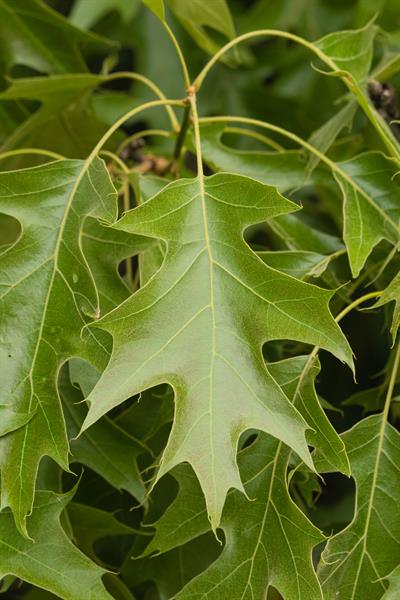
ID notes:On larger forest trees, Quercus velutina can be distinguished from Q. rubra by its inner bark color (yellow-orange), typically more plated bark (plates not just limited to lowest portion of trunk), and overall bent trunk stature (often slightly leaning on larger trees) vs. Q. rubra which has a more pink (salmon) colored inner bark and an overall straight stature (rarely leaning, or at least not noticeably so), with tightly furrowed bark throughout most of the trunk.
Origin/Endemic status: Native
Synonymy: = Ar, C, F, Fl2, FNA3, G, GrPl, Il, K1, K3, K4, Mi, NcTx, NE, NY, Pa, RAB, S, S13, Tn, Tx, Va, W, WH3, WV
Heliophily: 6
Hover over a shape, letter, icon, or arrow on the map for definition or see the legend.
 © Keith Bradley | Original Image ⭷
© Keith Bradley | Original Image ⭷ © Richard & Teresa Ware CC-BY-NC, permission granted to NCBG | Original Image ⭷
© Richard & Teresa Ware CC-BY-NC, permission granted to NCBG | Original Image ⭷ © Alaina Krakowiak, some rights reserved (CC BY-NC), uploaded by Alaina Krakowiak source CC-BY-NC, permission granted to NCBG | Original Image ⭷
© Alaina Krakowiak, some rights reserved (CC BY-NC), uploaded by Alaina Krakowiak source CC-BY-NC, permission granted to NCBG | Original Image ⭷ © Erik Danielson source | Original Image ⭷
© Erik Danielson source | Original Image ⭷ © Scott Ward | Original Image ⭷
© Scott Ward | Original Image ⭷ © Scott Ward, some rights reserved (CC BY), uploaded by Scott Ward source CC-BY | Original Image ⭷
© Scott Ward, some rights reserved (CC BY), uploaded by Scott Ward source CC-BY | Original Image ⭷ © Bruce A. Sorrie | Original Image ⭷
© Bruce A. Sorrie | Original Image ⭷ © Scott Ward | Original Image ⭷
© Scott Ward | Original Image ⭷ © Richard & Teresa Ware CC-BY-NC, permission granted to NCBG | Original Image ⭷
© Richard & Teresa Ware CC-BY-NC, permission granted to NCBG | Original Image ⭷ © Richard & Teresa Ware CC-BY-NC, permission granted to NCBG | Original Image ⭷
© Richard & Teresa Ware CC-BY-NC, permission granted to NCBG | Original Image ⭷ © Gary P. Fleming | Original Image ⭷
© Gary P. Fleming | Original Image ⭷ © Gary P. Fleming | Original Image ⭷
© Gary P. Fleming | Original Image ⭷ © Joey Shaw source | Original Image ⭷
© Joey Shaw source | Original Image ⭷ © Joey Shaw source | Original Image ⭷
© Joey Shaw source | Original Image ⭷ © Richard & Teresa Ware CC-BY-NC, permission granted to NCBG | Original Image ⭷
© Richard & Teresa Ware CC-BY-NC, permission granted to NCBG | Original Image ⭷ © Erik Danielson source | Original Image ⭷
© Erik Danielson source | Original Image ⭷ © Erik Danielson source | Original Image ⭷
© Erik Danielson source | Original Image ⭷ © Erik Danielson source | Original Image ⭷
© Erik Danielson source | Original Image ⭷ © Erik Danielson source | Original Image ⭷
© Erik Danielson source | Original Image ⭷ © Erik Danielson source | Original Image ⭷
© Erik Danielson source | Original Image ⭷ © Erik Danielson source | Original Image ⭷
© Erik Danielson source | Original Image ⭷Feedback
See something wrong or missing on about Quercus velutina? Let us know here: (Please include your name and email if at all complicated so we can clarify if needed.)
Cite as...